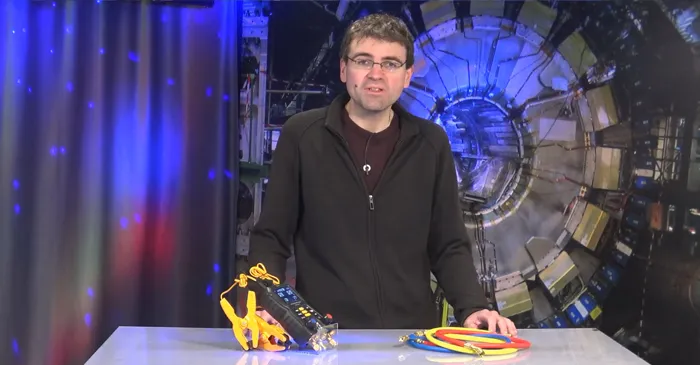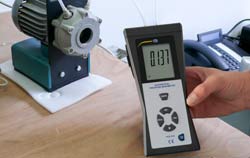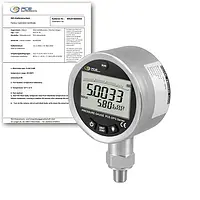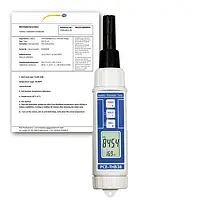Use of cookies
Please select if the website is allowed to use only neccessary cookies or also functional cookies, as described on below link:
Your current selection: {status}
Change selection:
The PCE-THB 38 Manometer is ideal for detecting and digitally displaying humidity, temperature and barometric pressure. Temperature is measured by an RTD sensor and air humidity is measured by a highly repeatable, capacitive sensor. All products are test instruments, and the Manometer is sent out manufacturer calibrated. An ISO certification is available optionally.
While the original manometer was a liquid column gauge, today's manometers employ many different methods of pressure measurement. For example, a flanged manometer is a pressure gauge that normally uses a round diaphragm or spring clamped between two flanges to measure pressure. Other pressure gauges use electronic pressure sensors based on piezoresistive strain, capacitive, magnetic, piezoelectric, optical or potentiometric measurement principles.
Pressure measurements can be expressed in a number of different measuring units, depending on industry, application and regional preferences. Following is a conversion table depicting some of the more commonly used pressure measuring units.
What kind of manometer do you need? Purchase decision support
As a customer, you can always call the technical consulting hotline of PCE Instruments  +44 ( 0 ) 161 464902 0. The colleagues will ask you specific questions about your application and suggest the best suited products for the solution of your measuring task.
+44 ( 0 ) 161 464902 0. The colleagues will ask you specific questions about your application and suggest the best suited products for the solution of your measuring task.
Below you will also find some tips which you should take into consideration when selecting or purchasing a manometer.
The essential criteria by which a manometer should be selected are the display range and the resistance of the materials against temperature, measuring medium and environment.
Criteria when selecting a device:
In our product range you will find manometers with analogue and digital displays. Analog manometers employ mechanical measuring methods; therefore, analog manometers or pressure gauges require little to no maintenance. Because there are no electronics, analog pressure gauges are quite easy to use. Because of the shock-proof and robust housing, the analog manometers are mostly applied in workshops or in industry. A further advantage of the analog manometers is the ease of use – you only have to screw the analog manometer into the pressure system and read the measured value from the analog display.
Our digital manometers are battery operated and therefore ideal for mobile use. The measured values can be displayed in the units of bar, psi, Pa, or Mpa (in handheld devices up to 11 units possible). The digital manometers offered by PCE Instruments have various functions, for example storing the Min-Max values or an automatic shutdown.
In general, in case of manometers, a distinction is made between absolute, relative and differential pressure.
The absolute pressure refers to the pressure zero in the vacuum and is particularly interesting for air pressure measurements. To measure an absolute pressure, you can use altimeters and barometers available in our product range.
Relative pressure references ambient air pressure or atmospheric pressure. The relative pressure is divided into overpressure and negative pressure. If the air pressure of 0 bar is assumed, positive values are obtained for the pressure above it, which is referred to as overpressure. If the value is below the air pressure of 0 bar, we get a negative value and we then speak of a negative pressure. In practice, manometers are most commonly used for the determination of relative pressure.
Differential pressure references the difference in pressure between two points. The main feature of differential pressure manometers are the two separate pressure connections, for example, for measuring the pressure before and after pumps. Differential pressure manometers are often used where pressures are compared with each other. This can be in the case of a sluice in order to control fans, to detect the pressure in front of and behind a filter to determine the degree of soiling or also air speed, with the help of a pitot tube. Another example is an HVAC contractor who compares the difference in air pressure before and after a filter to determine whether or not the filter is soiled and needs to be replaced. To measure the differential pressure, you can use the handheld measuring instruments from our product range.
When selecting your manometer, please consider which medium it should be used for.  The manometers we offer can measure the pressure in the air, liquids and gases. In the technical specifications of manometers, you can see which medium each device is compatible with. Some of our manometers have to be configured accordingly. It is also important to know if the material abrasive or acidic. The nature of the material helps narrow down the selection of manometer products to only those compatible with the specific kind of material. For example, the type of membrane or diaphragm used in a flanged manometer or pressure gauge determines the gauge’s compatibility with certain kinds of liquids or gases. Ceramic diaphragms are highly resistant to process fluids with abrasive particles, but ceramic diaphragms can be incompatible with strong acids. Whereas stainless steel diaphragms are easy to clean and sterilize, and thus frequently used in the hygienic processing of food and pharmaceutical products. Safety note: with our manometers it is strictly prohibited to conduct measurements of explosive and corrosive gases or liquids!
The manometers we offer can measure the pressure in the air, liquids and gases. In the technical specifications of manometers, you can see which medium each device is compatible with. Some of our manometers have to be configured accordingly. It is also important to know if the material abrasive or acidic. The nature of the material helps narrow down the selection of manometer products to only those compatible with the specific kind of material. For example, the type of membrane or diaphragm used in a flanged manometer or pressure gauge determines the gauge’s compatibility with certain kinds of liquids or gases. Ceramic diaphragms are highly resistant to process fluids with abrasive particles, but ceramic diaphragms can be incompatible with strong acids. Whereas stainless steel diaphragms are easy to clean and sterilize, and thus frequently used in the hygienic processing of food and pharmaceutical products. Safety note: with our manometers it is strictly prohibited to conduct measurements of explosive and corrosive gases or liquids!
Will measurements be taken in multiple locations or just one? In other words, does the manometer need to be portable or stationary?
Depending on the application, at PCE Instruments, in the category Manometers, you will find a large selection of built-in and handheld instruments.
Our stationary manometers are ideal for continuous monitoring of pressure in various application fields. Stationary manometers can be digital or analogue. In addition, stationary manometers are particularly robust and therefore are ideal for harsh industrial environments. Digital manometers that are stationary have large, easy-to-read LCD screens that clearly display measurements in real time in pressure units such as bar, psi, Pa, etc. Some of our measuring instruments have an analogue output which is configurable as, for example, 4 ... 20 mA or as 0 ... 10 V. These differential pressure sensors are often used in control technology.
If you need a flexible manometer for spot-like measurements, you should opt for our mobile handheld devices. For example, a portable manometer can be used to check pipe pressures in multiple pump houses located throughout a municipality. A handheld differential pressure manometer can be used in a quality control laboratory to test air filters to ensure the filters interfere minimally with HVAC system performance. PCE's portable or handheld manometers are typically digital battery-powered devices with added functionality such as the ability to store minimum and maximum values or to record measurements over a period of time. Those manometers with data-logging capabilities often feature an SD card memory, USB port or RS-232 interface to transfer data to a PC for detailed analysis and reporting. In our shop you will find mobile digital manometers for application in the laboratory, for monitoring an outdoor installation or wherever some flexible measuring devices are required. The mobile manometers are supplied with software, which means that later the recorded data can be evaluated on the PC. This information is often used for quality control, troubleshooting or printout in documents.
Other important criteria when selecting a manometer are the measuring range and accuracy. It should be noted that the pressure to be expected should lie in the middle third of the manometer's display range. Our stationary pressure gauges have a measuring range of 0.1 … 600 bar and are divided into the accuracy classes 0.05 / 0.1 / 0.2 and 0.5. The mobile differential pressure gauges of the PCE range can measure pressures of +/- 1000 to +/- 7000 mbar with an accuracy of 0.3% or 2%.
The stationary manometers have different connections and diaphragms, that is why you should take a look at the technical data of our devices or ask one of our technicians for advice. The manometers are suitable for different liquids or gases depending on different diaphragms and are optionally supplied with a ceramic or a stainless-steel membrane.
Depending on the device, you have a choice of up to 6 different threaded connections, for example G ½ "DIN 3852 or ¼" NPT. In our online shop, you can select the desired thread and configure the manometer individually for your use.
If you have any questions about the products on this website, please contact us at or +44 ( 0 ) 161 464902 0.

